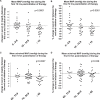Responsiveness to Vasoconstrictor Therapy in Hepatorenal Syndrome Type 1
- PMID: 36763632
- PMCID: PMC10278824
- DOI: 10.34067/KID.0000000000000068
Responsiveness to Vasoconstrictor Therapy in Hepatorenal Syndrome Type 1
Abstract
Key Points:
Raising the mean arterial pressure (MAP) during management of hepatorenal syndrome type 1 (HRS-1) is associated with improvement in kidney function, independently of baseline MAP or model for end-stage liver disease.
Raising the MAP by 15 mm Hg or greater leads to greater reduction in serum creatinine in HRS-1.
Norepinephrine use confers greater probability of improvement in kidney function in HRS-1 compared with midodrine/octreotide.
Background: Raising mean arterial pressure (MAP) during treatment of hepatorenal syndrome type 1 (HRS-1) with vasoconstrictors (VCs) is associated with renal recovery. However, the optimal MAP target and factors associated with response to VCs remain unclear.
Methods: Records from hospitalized patients with HRS-1 treated with VCs without shock were reviewed searching for those who achieved ≥5 mm Hg rise in MAP within 48 hours. We examined the relationship between the mean MAP achieved during the first 48–72 hours of VC therapy and the change in serum creatinine (sCr) up to day 14. Endpoints were >30% reduction in sCr without need for dialysis or death by day 14 (primary) or by day 30 (secondary).
Results: Seventy-seven patients with HRS-1 treated for 2–10 days with either norepinephrine (n=49) or midodrine/octreotide (n=28) were included. The median age was 52 years (interquartile range [IQR], 46–60), 40% were female, and 48% had alcoholic cirrhosis. At VC initiation, median MAP was 70 mm Hg (IQR, 66–73), and median sCr was 3.8 mg/dl (IQR, 2.6–4.9). When analyzed by tertiles of mean MAP increment (5–9, 10–14, ≥15 mm Hg), there was greater reduction in sCr with greater rise in MAP (ANOVA for trend, P < 0.0001). By multivariate logistic regression analysis, mean MAP rise during the first 48–72 hours (odds ratio [OR], 1.15 [1.02 to 1.299], P=0.025), norepinephrine as VC (OR, 5.46 [1.36 to 21.86], P=0.017), and baseline sCr [OR, 0.63 [0.41 to 0.97], P=0.034) were associated with the primary endpoint, whereas mean MAP rise during the first 48–72 hours (OR, 1.17 [1.04 to 1.33], P=0.012) and baseline sCr (OR, 0.63 [0.39 to 0.98], P=0.043) were associated with the secondary endpoint.
Conclusions: Greater magnitude of rise in MAP with VC therapy in HRS-1, lower baseline sCr, and use of norepinephrine over midodrine/octreotide are associated with kidney recovery. Targeting an increment of MAP ≥15 mm Hg may lead to favorable renal outcomes.
Figures



Comment in
-
Following the MAP for Improved Kidney Function in Hepatorenal Syndrome.Kidney360. 2023 Apr 1;4(4):e427-e428. doi: 10.34067/KID.0000000000000118. Kidney360. 2023. PMID: 37103955 Free PMC article. No abstract available.
References
Publication types
MeSH terms
Substances
Grants and funding
LinkOut - more resources
Full Text Sources

